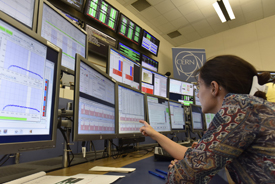CERN restarts particle collisions at record high energy
The 27 km long underground particle accelerator, the LHC (Large Hadron Collider) at CERN is once again in full swing and is colliding protons at record energies. This is after a break of more than two years to rebuild and upgrade the accelerator.
The LHC is now delivering particle collisions to all four of the large experiments with the record high energy of 13 TeV, which is almost double the previous energy and the world’s highest collision energy ever. The plan now is for the LHC to run around the clock for most of the next three years, opening the door to brand new discoveries.

The ALICE detector weighs over 10.000 tons, more than the Eiffel tower. Most of the mass is, however, concentrated in the large solenoid magnet (seen in red) which surrounds the inner detectors of ALICE. It is the world’s largest magnet and is operated at a field of 0.5 Tesla. This is sufficient to bend the trajectories of electrically charged particles that are produced in collisions in the middle of the detector and contributes to the identification of the particles (the lightest are bent most). The ALICE detector is special among the 4 large LHC detectors due to its ability to identify up to 80.000 particles for every single collision. The various detector systems inside ALICE surround the collisions point like layers of an onion. The detectors themselves are as light as possible to minimize interactions with the primary particles from the collisions.
In the LHC’s first 3-year period, researchers discovered the so-called Higgs particle, which was the last piece in the puzzle known as the Standard Model – this is the theory that describes the fundamental particles that everything in universe is made up of along with the forces acting between them.
“The discovery of the Higgs particle in June 2012 was a momentous discovery. Now the race is on to discover, among other things, dark matter, supersymmetry or perhaps something completely unexpected,” says particle physicist Troels Petersen, who works with the CERN experiments and is based at the Niels Bohr Institute at the University of Copenhagen. Troels Petersen works on the ATLAS experiment, which together with the CMS experiment discovered the Higgs particle.
Enormous energy
Around 10AM this morning, the LHC operator crew announced that there were ‘stable particle beams’ for the experiments, which could then start taking data. The beams consist of bunches of protons traveling at nearly the speed of light around the 27 km long accelerator ring. These so-called proton bunches travel around the ring in opposite directions, controlled by powerful superconducting magnets and at four locations – at the large experiments, ATLAS, ALICE, CMS and LHCb the beams cross each other so that collisions between the protons can occur.
This morning the LHC was filled with 3 bunches, each containing about 100,000 billion protons. The number of bunches will eventually be increased to 2,800 bunches per beam and resulting this will result in up to 1,000 billion collisions per second. It is in such collisions that the enormous kinetic (motional) energy of the colliding particles can be transformed into mass in the form particles and antiparticles, in particular hand hopefully into new heavy particles that we have not been able to detect before.
New chapter in exploration
Later in the year the LHC will break yet another record by colliding nuclei of lead at the highest center-of-mass energy ever achieved, about 1000 TeV. In every single central lead-lead collision it is expected that up 35.000 particles will be produced. The enormous energy density will accurately recreate the conditions of the early Universe, as they were about a nanosecond after the Big Bang.

One of the LHC operators, Laurette Ponce, analyses the many screens of data that physicists use to monitor and operate the machine (Image: M.Brice/CERN)
“We embark today on a new and unique chapter in the exploration of the fundamental constituents of matter and the forces that bind them together. The jump in energy that we take today opens new doors and has the potential to reveal new layers in our understanding of the microcosmos that constituted the early stages of the macro cosmos that we live in today, our observable Universe. There is the possibility for new discoveries that may revolutionize our view of physics and provide explanations for the 95% of the energy in the Universe for which we presently have no explanation. In any case, we are now reaching an energy scale, under controlled laboratory conditions, which is not likely to be surpassed the next 30 to 40 years. So, it is a wonderful discovery trip that awaits us with the possibility to draw entirely new maps of unchartered territory”, explains professor Jens Jørgen Gaardhøje, who leads the research group at the Niels Bohr Institute working with the ALICE experiment.
The group is responsible for one of the ALICE detector systems and had it at the ready this morning for first data taking. The start was however not entirely without problems as an electronics high voltage card failed yesterday requiring physicist Kris Gulbrandsen from NBI to rush to CERN for a nightly last minute repair!
During the two-year shutdown, the four large experiments have undergone improvements to prepare them for the new energy level and the increased intensity. Now the experiments have started again and this marks the beginning of a new era in the exploration of the mysteries of nature.
Jens Jørgen Gaardhøje, professor, Niels Bohr Institute, Universitety of Copenhagen, +45 3532-5309, +45 2099-5309, gardhoje@nbi.ku.dk
Troels C. Petersen, Associate professor, Niels Bohr Institute, Universitety of Copenhagen, +45 3532-5442, petersen@nbi.ku.dk
